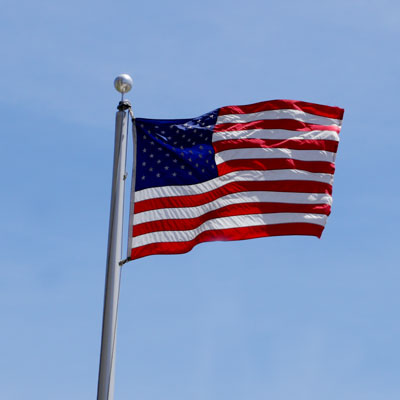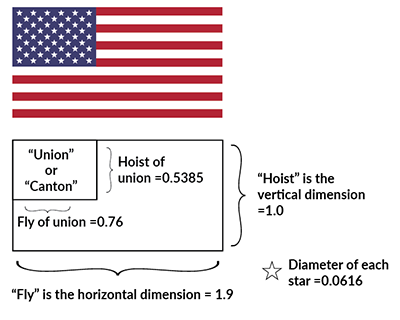Flag Etiquette
 The Office of the Minnesota Secretary of State provides information and resources for citizens interested in flag etiquette—the protocol for handling and displaying the flag of the United States and other flags.
The Office of the Minnesota Secretary of State provides information and resources for citizens interested in flag etiquette—the protocol for handling and displaying the flag of the United States and other flags.
To request flag etiquette brochures for your organization, contact the office at 651-201-1324 or by email at secretary.state@state.mn.us.
History of the United States Flag
On June 14, 1777 the Continental Congress established an official flag for the new United States by passing the Flag Act:
"Resolved, That the flag of the United States be made of thirteen stripes, alternate red and white; that the union be thirteen stars, white in a blue field, representing a new Constellation."
The design of the flag continued to evolve throughout our nation's history. Read more at USFlag.org.
To learn more about flags and flag design, visit the North American Vexillological Association at NAVA.org.
The United States Flag
The U.S. flag has 13 horizontal stripes—alternating seven red and six white—with the red stripes at top and bottom. The canton, or union of navy blue, occupies the upper left-hand quarter next to the staff and extends from the top to the lower edge of the fourth red stripe. The 50 stars in the blue union represent the number of states. The stars are arranged, with one point up, in nine horizontal rows. The following diagram provides flag terminology and gives official dimensions of the flag: Based on taking HOIST as 1, all other dimensions of the flag have a proportion as shown, regardless of variations in overall size.
Minnesota Flag
Minnesota's first state flag, adopted in 1893, had a ground of white on one side and light blue on the other, with the state seal in the center on both sides. The current flag was adopted in 2024 - find more information about it on the Minnesota flag webpage.
Flag Etiquette Guide
The United States Code, Title 36 sets guidelines for display of and respect shown to the United States flag. Below are some of the guidelines. For a complete explanation, see USFlag.org or Congressional Resource Service [pdf].
For information regarding the laws and provisions related to flag etiquette in Minnesota see:
- Minnesota Law Library summary of flag laws
- Minnesota law governing the Minnesota state flag, and law imposing penalties for flag misuse
Minnesota's governor may order the United States flag or the Minnesota flag to be flown at half-staff on state property. At the Flags at Half-Staff webpage of the Governor's Office, you can sign up for notifications when such an order is issued.
The President of the United States may also order the United States flag to be flown at half-staff. Many sites publish this information for the United States flag, including halfstaff.org.
Displaying the United States Flag
- It is the custom to display the flag from sunrise to sunset on buildings and stationary flagstaffs in the open. For patriotic effect, the flag may be displayed 24 hours a day if properly illuminated.
- The flag should be hoisted briskly and lowered ceremoniously.
- The flag should not be displayed during inclement weather, except when an all-weather flag is displayed.
- The flag should be displayed daily on or near the main administration building of every public institution.
- The flag should be displayed during school days in or near every school.
Proper Display of the United States Flag
Here are the rules for proper display and use of the U.S. flag, as established by generally accepted custom and by Public Law 829, approved by Congress as the “Federal Flag Code.”
- The U.S. flag, when carried in a procession with another flag, should be on the marching right, that is, the flag’s own right. If there is a line of other flags, the U.S. flag should be in front of the center of that line.
- The flag should not be displayed on a float in a parade except from a staff.
- The flag should not be draped over the hood, top, sides, or back of a vehicle or on a railroad train or a boat. When the flag is displayed on a motorcar, the staff shall be fixed firmly to the chassis or clamped to the right fender.
- No other flag or pennant should be placed above or, if on the same level, to the right of the U.S. flag. Flags of other nations should not be flown below or behind the U.S. flag, but rather on separate poles, at the same level and to the flag’s left.
- The U.S. flag, when displayed with another flag against a wall from crossed staffs, should be on that flag’s own right, and its staff should be in front of the other.
- The U.S. flag should be at the center and highest point of a group when several state or local flags or pennants are grouped and displayed from staffs.
- When flags of states or localities, or pennants of societies are flown on the same halyard with the U.S. flag, the latter should be at the peak. When the flags are flown from adjacent staffs, the U. S. flag should be hoisted first and lowered last.
- When the U.S. flag is displayed from a staff projecting horizontally or at an angle from the window sill, balcony, or front of a building, the union of the flag should be placed at the peak of the staff.
- When displayed either horizontally or vertically against a wall, the union should be uppermost and to the flag’s own right (the observer’s left). When displayed in a window, the flag should be displayed in the same way, with the union or blue field to the left of the observer in the street.
- When the flag is displayed over the middle of a street, it should be suspended vertically with the union to the north in an east-west street or to the east in a north-south street.
- When used on a speaker’s platform, the flag, if displayed flat, should be displayed above and behind the speaker.
- When displayed from a staff in a church or public auditorium, the U.S. flag should hold the position of superior prominence, in advance of the audience, and in the position of honor at the speaker’s right, facing the audience. Any other flag so displayed should be placed on the left of the speaker or to the right of the audience.
- The flag, when flown at half-staff (one-half the distance between the top and bottom of the staff), should be first hoisted to the peak for an instant and then lowered to the half-staff position. The flag should be again raised to the peak before it is lowered for the day. On Memorial Day, the flag should only be displayed at half-staff until noon, then raised to the top of the staff. By order of the President, the flag shall be flown at half-staff upon the death of principal figures of the U.S. Government or the governor of a state, territory, or possession, as a mark of respect to their memory.
More Rules for Display and Conduct
- When the flag is used to drape a casket, it should be so placed that the union is at the head and over the left shoulder. The flag should not be lowered into the grave or allowed to touch the ground.
- When the flag is suspended across a corridor or lobby in a building with only one main entrance, it should be suspended vertically with the union of the flag to the observer’s left upon entering. If the building has more than one main entrance, the flag should be suspended vertically near the center of the corridor or lobby with the union to the north, when entrances are to the east and west or to the east when entrances are to the north and south. If there are entrances in more than two directions, the union should be to the east.
- No disrespect should be shown to the U.S. flag; the flag should not be dipped to any person or thing. Regimental colors, state flags, and organization or institutional flags are dipped as a mark of honor.
- The flag should never be displayed with the union down, except as a signal of dire distress in instances of extreme danger to life or property.
- The flag should never touch anything beneath it, such as the ground, the floor, water, or merchandise.
- The flag should never be carried flat or horizontally, but always aloft and free.
- The flag should never be used as wearing apparel, bedding, or drapery. It should never be festooned, drawn back, nor up, in folds, but always allowed to fall free.
- The flag should never be fastened, displayed, used, or stored in such a manner as to permit it to be easily torn, soiled, or damaged.
- The flag should never be used as a covering for a ceiling.
- The flag should never have placed upon it, nor on any part of it, nor attached to it any mark, insignia, letter, word, figure, design, picture, or drawing of any nature.
- The flag should never be used for advertising purposes. It should not be embroidered on such articles as cushions or handkerchiefs and the like, printed or otherwise impressed on paper napkins or boxes or anything that is designed for temporary use and discard. Advertising signs should not be fastened to a staff or halyard from which the flag is flown.
- No part of the flag should ever be used as a costume or athletic uniform. However, a flag patch may be affixed to the uniform of military personnel, firemen, policemen, and members of patriotic organizations. Lapel flag pins should be worn on the left lapel near the heart.
- The flag, when it is in such condition that it is no longer a fitting emblem for display, should be destroyed in a dignified way, preferably by burning.
- Conduct During Hoisting, Lowering, or Passing of the American Flag in a Parade:
All persons present in uniform should render the military salute. Members of the Armed Forces and veterans who are present but not in uniform may render the military salute. All other persons present should face the flag and stand at attention with their right hand over the heart, or if applicable, remove their headdress with their right hand and hold it at the left shoulder, the hand being over the heart. Citizens of other countries present should stand at attention. All such conduct toward the flag in a moving column should be rendered at the moment the flag passes.